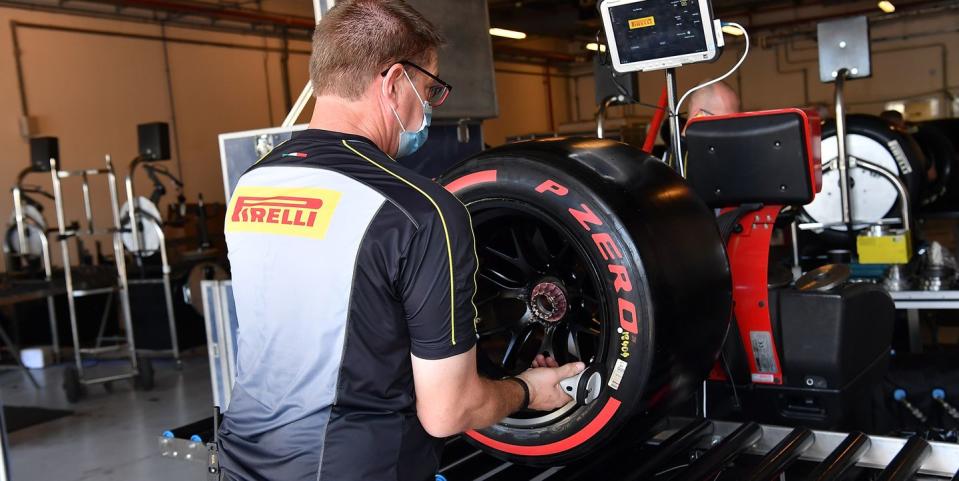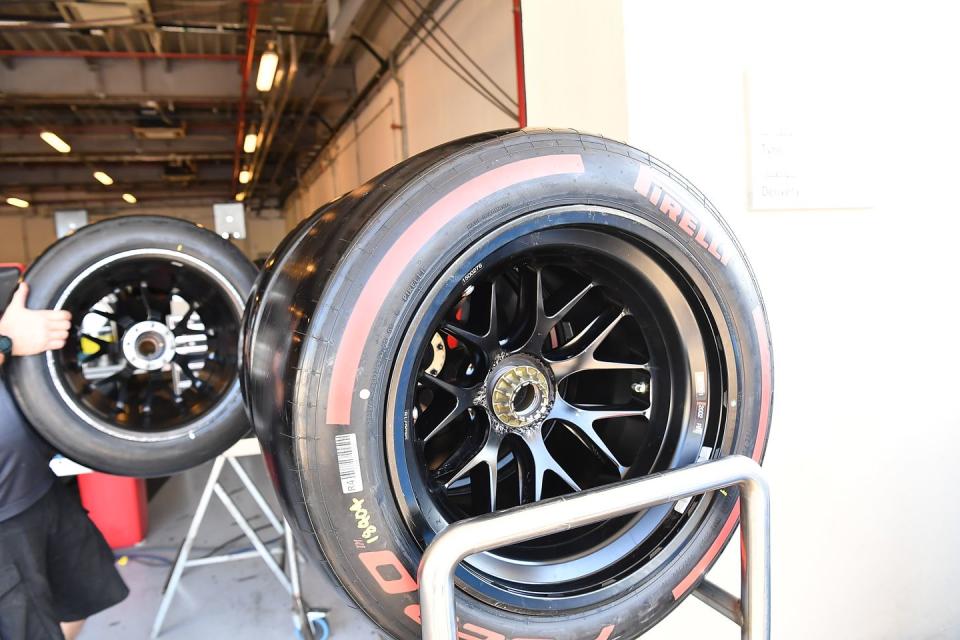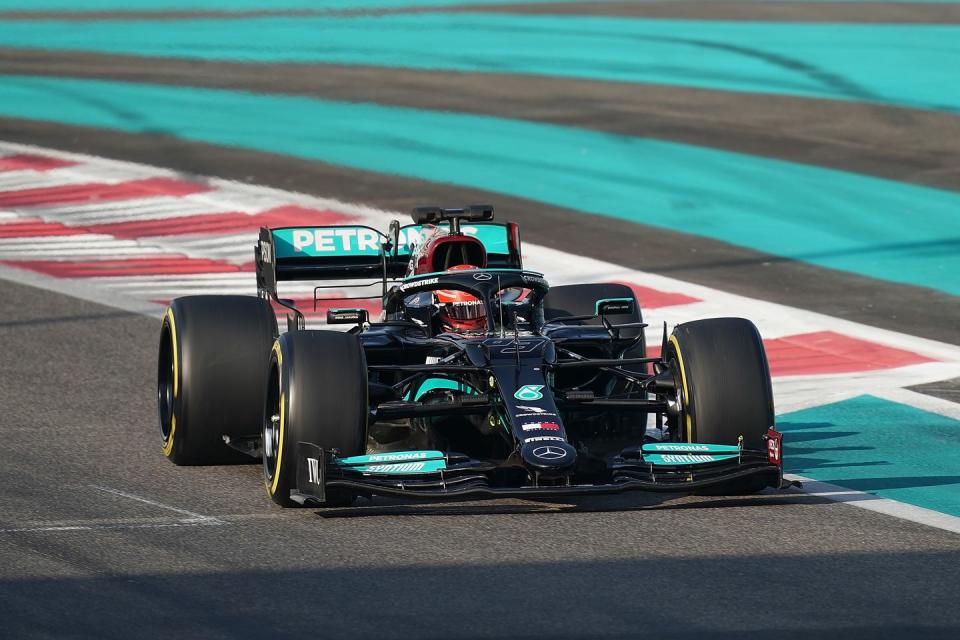Why Formula 1 Is Going to 18-Inch Tires, and What to Expect

Formula 1's move from 13-inch to 18-inch tires was pushed back from 2021 to 2022 due to the COIVD-19 pandemic.
Pirelli says the 18-inch tire is good for technology transfer from race to road, because the sizes are a lot more relevant compared to the 13-inch.
Pirelli has to create five dry-weather compounds—along with the wet-weather Intermediates and Wets—of which three are selected for each Grand Prix.
Formula 1’s tires will undergo a transformation for 2022.
Gone are the 13-inch tires that have been present for decades, and in their place come 18-inch tires, again provided by sole supplier Pirelli, which has held the role since 2011. The new sizes are part of the wide-ranging technical changes being introduced for 2022.
“It was a decision made based on the new package,” said Pirelli’s Formula 1 boss Mario Isola. “The 18-inch tires are probably the most visible part of the car. It is part of an idea coming from F1 to make F1 more modern, with the possibility to have closer action on track.
“We are obviously very happy as moving to an 18-inch tire is good for our technology transfer from race to road, because the sizes are a lot more relevant compared to the 13-inch.”
It has been a challenging development program for Pirelli, which began in mid-2019, and was then prolonged when the pandemic prompted unanimous agreement for the new regulations to be deferred from 2021 until 2022.
Pirelli has to create five dry-weather compounds—along with the wet-weather Intermediates and Wets—of which three are selected for each Grand Prix. It works to a target letter agreed with major stakeholders Formula 1 and the FIA, which includes desirable elements such the delta between compounds and the strategic ambition. Pirelli thus has to consider different car performance, which evolves as clever designers unearth more lap time, 23 circuits with varying characteristics and demands, and temperature fluctuations.
Furthermore, regulations dictate that each driver per weekend has eight Softs, three Mediums and two Hards; and one of the Medium or Hard must be run in race trim. Getting tire compounds that are just right, and which have sufficient lap time and degradation differences to produce offset strategies so that everyone doesn’t converge to the same approach… talk about a tough task.
“We had to redesign not only the construction, the profile, but also the range of compounds,” said Isola. “In the target letter we agreed with the stakeholders we have a number of parameters that are different to 2021, and previous seasons,” said Isola. “The delta lap time has been reviewed and the level of degradation as well, with these numbers we should have a mix of one to two stops in the races.”
Testing has been ongoing since mid-2019 using that season’s cars slightly modified in order to accommodate the revised tire sizes. Only Williams, which was not in a financial position to commit to extra testing, has been absent; Pirelli is allocated 25 days test per year that is split between teams, which usually supply race drivers, and the company provides the run program. Data and information gathered is distributed to all teams equally to ensure there is no advantage.

For 2022, part of the target letter involves a desire for the tires to have a wider operating window, and be more robust in race trim, but it remains a difficult science to accurately assess.
“To confirm that the new tires have less overheating we told the drivers in the long runs to push without any saving or without any management,” said Isola. “And they did it and their feedback was, ‘I can push more, I can feel the grip staying there for a lot of laps’, whereas with the current tires they had to manage a lot more.
“When the drivers tell you there is less overheating because ‘I can push and drive more aggressively and still have the grip and still see the lap time’, that’s the best feedback we can have. But there is one element we cannot reproduce in testing, and that is traffic, as we have only one or two cars on track.”
However, the debut of the new 18-inch tires coincides with Formula 1’s revised aerodynamic regulations. Part of the problem in recent seasons has been drivers struggling in the turbulent wake created by the car ahead due to the massive downforce levels produced. The new regulations aim to tackle that by relying less on the over-complicated wings and aero devices for downforce. The so-called ‘dirty air’ should be significantly reduced.

“I’m confident with the new aero package we can improve that (tire issues), as if when you follow the car in front you will lose maximum 10% downforce not 40% it is a different story,” said Isola. “If the drivers lose downforce, they lose performance. And if they lose downforce, they start sliding. And if they slide, they start overheating the surface of the tire and they lose grip—so it’s a double effect.
"If they still have the downforce and the tire is pushed on the ground and it doesn’t slide then you can keep the surface temperature in range and can attack more. So hopefully with the aero package and the new tire we can achieve the result—not necessarily more overtaking as the car in front also has less degradation, but it means we have closer racing overall.”
The phrase ‘keeping the tire in the right window’ has oft been trotted out in explaining subdued performances by teams; it is hoped that potential set-up headache will be eased in 2022, if not diminished entirely.
“When we are defining the working range, the working range is defined by the top of grip minus a certain percentage,” said Isola. “So the grip is always on a curve. You can design a curve that is peakier, or a curve that is a lot flatter. But you have a peak in both cases. We have to accept from the peak of grip, there is a decrease of grip over certain percentage, and this defines the working range.

 Yahoo Autos
Yahoo Autos 